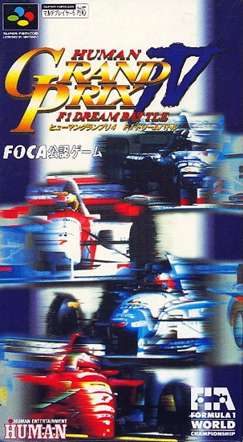Human Grand Prix IV: F1 Dream Battle
| Human Grand Prix IV: F1 Dream Battle | |
|---|---|
 Cover art | |
| Developer(s) | Human Entertainment[1] |
| Publisher(s) | Human Entertainment[2] |
| Composer(s) | Yukie Sugawara[3] |
| Series | Human Grand Prix |
| Platform(s) | Super Famicom[1][4] |
| Release date(s) | |
| Genre(s) | Racing[1] |
| Mode(s) |
Single-player Multiplayer (up to four players) |
Human Grand Prix IV: F1 Dream Battle (ヒューマングランプリ4 F1ドリームバトル, "Human Grand Prix 4 F1 Dream Battle")[5] is a Formula One racing video game for the Super Famicom. Up to four players can play and it has two different types of regular season modes in addition to battle and time trial modes.
Even though the game was only released in Japan, all in-game texts are in English.
Gameplay
Pit crew
A realistic pit crew fills up the player's fuel, fixes up all of the damaged components, and allows the players to choose from four different types of normal tires and four different types of rain tires. Reminders are given inside the vehicle and are assigned either a yellow code, a red code, or a blank code. Yellow codes can be safely ignored (except for fuel), red codes mean that the problem needs to be attended to at the pits, and blank codes means that the component is functioning perfectly. There are two different variations of tires with four degrees of hardness. The A tires are considered to be the hardest while the D tires are considered to be the softest.
Options
A fantasy mode allows for either re-enactments of past Formula One championships or opportunities to change history. Alternatively, the real world mode is an actual representation of the 1995 Formula One season that is used with the drivers from 1995. Actual Formula One courses from the 1995 season are used and the object is to win as many races as possible so that a championship can be earned. Championships can be won in either the drivers' division, the constructors' division, or in both. Working as a team will come in handy when a crucial finishing moment in the race can mean the difference between winning the championship for your constructor or finishing the season without a championship win.
In the edit menu, contracts can be edited between drivers and new drivers can be created by manipulating the vital statistics of fictional Formula One drivers. The configuration (config) menu allows the players to make the game either harder or easier by changing the speed of the rival cars, the harshness of on-track collisions, the number of laps in a season, and the quickness of the pit crew to fix any damages and refuel the vehicle.
Records
Records are held in a battery save in order for players to beat their personal best times. The race car drivers in this game use their actual names instead of names that sound similar to the actual drivers. Players can use cars from the 1992, 1993, 1994, or 1995 Formula One seasons. Separate records are held for battle and time attack because these are considered to be two separate forms of racing.
In order to save a record, one must use his personal name or a nickname that is up to eight characters long. Records are saved to the person not to the race car driver in order to differentiate between players who happen to play as the same driver(s). In the main menu, there is a special section for seeing past records (provided that no one erases the save game RAM). If the player does not qualify to beat a current record, then the player is not allowed to insert his name into the game.
Graphics
Graphic clarity is considered to be one the clearest when compared to all the other Human Grand Prix games. In one example using the Canadian Grand Prix in Montreal, the Montreal Biosphère as well as the two bridges that cross near Île Notre-Dame where the Circuit Gilles Villeneuve race track are shown in stunning detail for a game released in 1995. Another example are the Fuji TV signs that are shown on the walls of the Suzuka track that is the home to the Japanese Grand Prix. Another example of this graphic clarity is shown on the race cars themselves, the most notable being Red Bull (on Saubers) and Nokia (on Tyrrells) logos.
References
- 1 2 3 4 "Release information". GameFAQs. Retrieved 2008-05-02.
- ↑ "Publisher information". Allgame. Retrieved 2008-10-06.
- ↑ Composer information at SNES Music
- ↑ ヒューマングランプリ4 F1ドリームバトル at super-famicom.jp (Japanese)
- ↑ "Japanese title". Infoseek. Retrieved 2008-05-02.